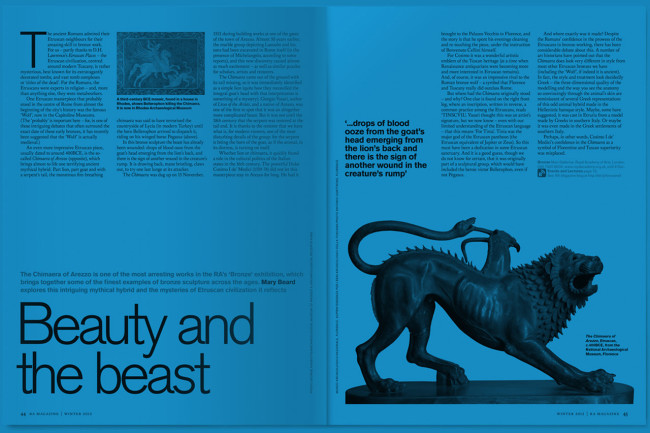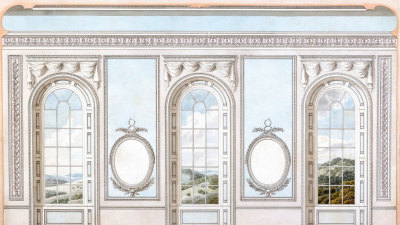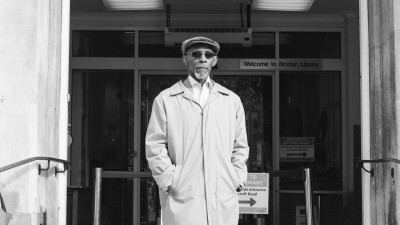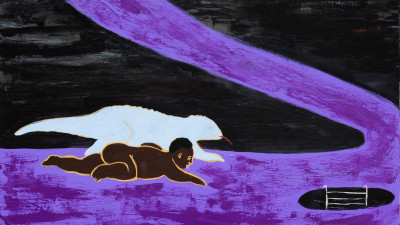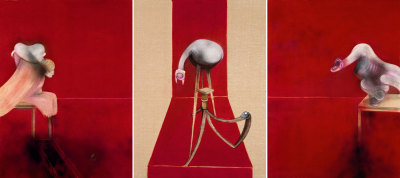From pencil and paper to virtual reality: working from life today
From pencil and paper to virtual reality: working from life today
By Ben Luke
Published 4 December 2017
With our current exhibition exploring the past, present and future of working from life, art critic Ben Luke explores how today’s artists are rethinking this seemingly traditional process in innovative, unexpected ways.
-
It is a painting that helped define our image of the Royal Academy. Johan Zoffany pictured a gathering of Royal Academicians as the institution was founded, presumably commissioned by the Academy’s patron, George III, and located ever since in the Royal Collection. And the setting he chose? The old life-drawing room at Somerset House, the Academy’s first permanent home. It is a painting rich in detail: Joshua Reynolds under the lamp with his ear trumpet listening as Francis Milner Newton speaks; George Michael Moser, then responsible for the RA Schools as the Keeper of the Royal Academy, setting the model’s pose, with a sling supporting his hand to allow him to hold it for longer; a piece of chalk on the model’s platform which would have helped mark his pose; and Zoffany himself on the far left, palette in hand, looking out at the viewer. Tellingly, as well as two models, all around are casts of classical sculptures.
-
Johan Zoffany RA, The Academicians of the Royal Academy, 1771-72.
Royal Collection Trust / © Her Majesty Queen Elizabeth II 2017.
-
Zoffany’s painting tells us that life drawing, and discussion about it, has been at the core of the RA’s activities, a notion explored in depth in the Academy’s new exhibition From Life. A mezzotint copy after Zoffany’s painting features among the historic works at the beginning of the RA show, but from there on, the exhibition looks not to the past but to the present and future, bringing together a diverse group of international contemporary artists. These include those who continue to make work using the kind of media that Zoffany would recognise, such as Academicians Jenny Saville, Michael Landy and Chantal Joffe, but also artists working in the expanded field of media that entered the lexicon of art in the 20th and 21st centuries, such as Jeremy Deller and Yinka Shonibare RA. The continued engagement with architecture is reflected in the exhibition with work by Farshid Moussavi RA. And Lucian Freud – who, despite his death in 2011 still feels very much alive through his ever-present work – also makes a cameo.
The idea is to explore what working from life means in the 21st century. A series of life-drawing classes, led by special guest tutors, accompany the exhibition; members of the public can enter a ballot for a place at a free class. A book Artists Working from Life includes interviews with all the artists involved in the exhibition, revealing an illuminatingly broad range of approaches and techniques. Even those working in the most conventional media explore the idea of working from life in noticeably different ways.
-
-
Ellen Altfest, the American artist, scrutinises her models for long periods, and creates paintings in oil on canvas that are minutely detailed yet could never be described as photorealist. Her work in the From Life show, The Butt (2007) reflects her interest in zooming in on body parts, in this case the lower back and upper backside of her model. She captures the weight and spread of flesh as it comes into contact with a hard, paint-caked wooden stool, which she describes with the same fidelity. Altfest doesn’t trouble herself with traditional rules on the depiction of the human figure – this is an unidealised (for which, read real) image of the human body: a little overweight, hairy, veiny, tan-lined. But it is also an abstraction, an all-over painting, in which, as she tells Michael Prodger in the book, she forgets the body part she’s painting and becomes embroiled in the physical demands of the work. “I’m very absorbed, involved”, she says. “I’m trying to push the painting”.

-
-
-
Experimenting with media while retaining a commitment to observation is at the heart of Jenny Saville’s latest work. Saville emerged in the 1990s as the inheritor of a fleshy painterly tradition which seemed to reach back to Titian. Though meaty paint was initially her trademark, drawing has come to play an increasingly dominant role in her work, and her most recent works have featured several superimposed drawings, forming a web of lines that sometimes coalesce into bodies, unified or composite. These days, these are more often made from photographs that she takes or finds rather than using a model (though Saville spent much time in the Life Room at Glasgow School of Art in the late 1980s). But her work in From Life is from an earlier group focusing on faces of people who had experienced extreme trauma. Entry (2004-05) features the face of a person with a vast entry wound, presumably a bullet wound, close to their nose. It is a philosophical play on the idea of painting “from life” – Saville is in fact painting from death, from a forensic pathology book, yet capturing the face with the vitality of mark-making (if not of colour) that she employs in her images of the living. It is also inevitably a still life, not a portrait of a living being – a gruesome vanitas for our age.

-
-
-
Saville’s appearance on the art scene in the UK saw her art immediately linked with Lucian Freud, partly because her paintings of weighty, fleshy bodies coincided with the extraordinary purple patch in Freud’s career where he depicted two imposingly bulky figures: the performance artist Leigh Bowery and the benefits supervisor Sue Tilley. But Freud came to represent an extreme in working from life, quite distinct from Saville. He would never use photographs, for instance. As Martin Gayford writes in the book: “He would work exclusively from real objects, rooms, animals and people, and he would only work when all the contents of a picture were in front of his eyes”.
Often, that ensemble would be together for months on end as Freud worked through a painting. And it would all begin with drawing: Freud would describe the scene in charcoal first, then rub it down with a cloth, leaving a trace of the drawing; this was the initial armature for the final painting. The exhibition includes a fascinating glimpse into this process, with a canvas marked only with the faintest of drawn marks and the quite highly rendered painting of just a neck, shoulders and the lower part of a face (A Beginning, Blond Girl, 1980). Aside from the intimacy of our encounter with this work – like reading the diary of this fiercely private enigma – it is fascinating technically. Many painters would block in the full composition in paint before going into greater detail; Freud zooms in as soon as he has the brush in his hand. It shows how crucial each moment of the painting process was to him: he had to get this detail down.

-
-
The artist in the RA show whose career began most conventionally is Jonathan Yeo. He first made his name with a portrait of the former UK Prime Minister Tony Blair and then went on to produce numerous other paintings of celebrities and creatives that could be described as society portraiture. But Yeo now rarely makes this type of portrait, and his works for From Life are his most experimental to date. He is one of four artists in the exhibition who has made new works with the virtual reality (VR) platform HTC Vive and the software programmes that can be used with it to make art: Google’s Tilt Brush and MakeVR Pro.
Yeo has launched himself into this new technological field with gusto, and produced two types of work. The first is a series of paintings that are self-portraits with a twist, made from studying 3D scans of himself. Usually, self-portraits are made in one of two ways – from looking in a mirror or from photographs. Both have drawbacks: the mirror is a reversed image, of course, and often projects the artist’s “concentration face” as they study their own features. Photographs might have a more faithful expression, but are two-dimensional. The 3D scans allow the artist to treat his own face much more like that of someone else: the expression is neutral and he can see it in the round. But his paintings of it are far from straight portraits. They reflect the interface between the human and the digital: in one, for instance, he plays with the idea of his face being part of an artificial intelligence being.
Yeo’s work within VR takes this playfulness a stage further. Working with Google Arts and Culture, he was able to incorporate the 3D scan of his head into virtual reality, where, with a headset on, he could observe it from all angles. Then using Google’s Tilt Brush, which turns wireless controllers into paintbrush and palette, he “painted” his own virtual self-portrait from the scan. This in turn has been cast in bronze: a collision of ancient and modern technologies. “I am not a sculptor, so you get a sense by looking at the work that it must have been made in a different way – a sense of movement and energy and light.” It is the very definition of new media: “It’s only in the last few months – weeks even – that it has been possible to extract and repurpose the VR files in this way.”
-
Jonathan Yeo works from his head scan inside virtual reality, using Google’s Tilt Brush software to create self-portraits
© Jonathan Yeo studio.
-
Yinka Shonibare also combines 3D scanning and VR. He has made a life-size scan from the RA’s 18th-century cast of the Townley Venus. The original Roman sculpture, itself a copy of a lost Greek original, was acquired by the artist and antiquary Gavin Hamilton before it entered the collection of the British Museum. The statue has been transformed by Shonibare’s trademark batik fabric and then 3D scanned again, so that it can appear in a VR recreation of Hamilton’s painting Venus Presenting Helen to Paris (c.1777-80), in which the viewer can step through the arch and into the background scenery. “My idea”, he told Michael Prodger, “is that people can enter Hamilton’s painting and encounter my sculptures there.”
-

Yinka Shonibare RA, The virtual reality presentation Venus Presenting Helen to Paris (with Townley Venus), 2017.

Gavin Hamilton, Venus offering Helen to Paris, 1785.
-
In her experiments with VR, the architect Farshid Moussavi RA has created an environment in which visitors to the exhibition can create variations on two great ribbed domes in Italy, Brunelleschi’s dome for the Duomo in Florence (1420–36) and Borromini’s for his Church of Sant’Ivo alla Sapienza (1632–60) in Rome – a fresh take on the idea of drawing from life, where the domes are the models whose form can be interpreted and adjusted. Moussavi told me that, while working from life “is something some artists may do and others may not do”, for architects “it is just degree zero. Architecture cannot escape everyday life”. She sees the potential for VR to draw architects’ clients deeper into the design journey, where it could be used to “involve end users in the process and understand better the possible actualisation of an architectural idea at its life-size scale”.
Sometimes, though, the VR experience can enhance artists’ appreciation of their more everyday tools. Humphrey Ocean has long seen chairs in the context of the human form that they support, a form he has studied over many decades. From designs made in VR, he will produce a chair from a mix of wood and resin, a kind of hybrid car and dining seat, complete with crash-test-dummy legs (a slightly ominous inclusion). Yet while he has enjoyed using VR, it has reinforced his feeling that “paint is ahead of the curve” as a technology. Though it is “nothing, it comes out of the ground under our feet”, paint has an almost alchemical ability to represent the physical aspects and emotional vitality of a sitter, as Ocean shows us in gouache paintings he makes in just an hour.
-
-
One of the most difficult aspects for artists working from life is to capture that vitality. For Antony Gormley, the traditional approach to life drawing has long seemed an inadequate means to do so. The life room seemed to him to be “a strange place where a real body was turned into a landscape – or, more to the point, an object”, he told Martin Gayford. He set about making what he describes as “the most accurate account I could of a moment of being. I was more interested in living inside a body than making a reproduction of what it looked like from the outside. In other words, I wanted to ask what it felt like to be alive…” The sculptures he makes from casts and scans of his own body are therefore about the sensation of “inhabiting” a body.

-
-
Sometimes a body’s vitality can be perceived in terms of its cultural significance. It is this that Jeremy Deller taps into in his work for the show. For a project hosted by the Brooklyn Museum in New York in 2016, he arranged for the rock star Iggy Pop to pose in an otherwise standard life class at the New York Academy of Art. As Deller told Sam Phillips, “Most life models are anonymous. Their identity doesn’t interfere with the execution and appreciation of the drawing”. But Iggy Pop’s is a body of deep significance, which he has used to express an almost animal energy during four decades of often near-naked performances. As Deller put it, this body is “emblematic of the art form that is rock music”. With his body depicted by skilled and novice artists, the results of Iggy Pop Life Class are somehow humble images of an ageing, if still very fit, body. Yet the modesty of the drawings also reflects an inadequacy in attempting to capture Pop’s true spirit, which enhances his mystique, and reinforces that essential, ineffable characteristic that propels certain figures to a position of cultural resonance.
-

Iggy Pop life class by Jeremy Deller. New York, 21 February 2016. Organised by the Brooklyn Museum
Photo: Elena Olivo © Brooklyn Museum
-
When From Life was first announced, Tim Marlow, the Academy’s Artistic Director, suggested that it “embodies what an artist-run academy was, is and might become”. More artists not discussed here take on different strategies again. But one thing is clear: that while fewer artists may sit in front of a model and depict them on paper, as urged by those founding Royal Academicians captured by Zoffany, the idea of making art from life has as much currency as ever.
-
Ben Luke is an art critic at the London Evening Standard and Features Editor at The Art Newspaper.
From Life is at the RA from 11 December 2017 to 11 March 2018.
-
-
Enjoyed this article?
Become a Friend to receive RA Magazine
As well as free entry to all of our exhibitions, Friends of the RA enjoy one of Britain’s most respected art magazines, delivered directly to your door.
Why not join the club?

-









